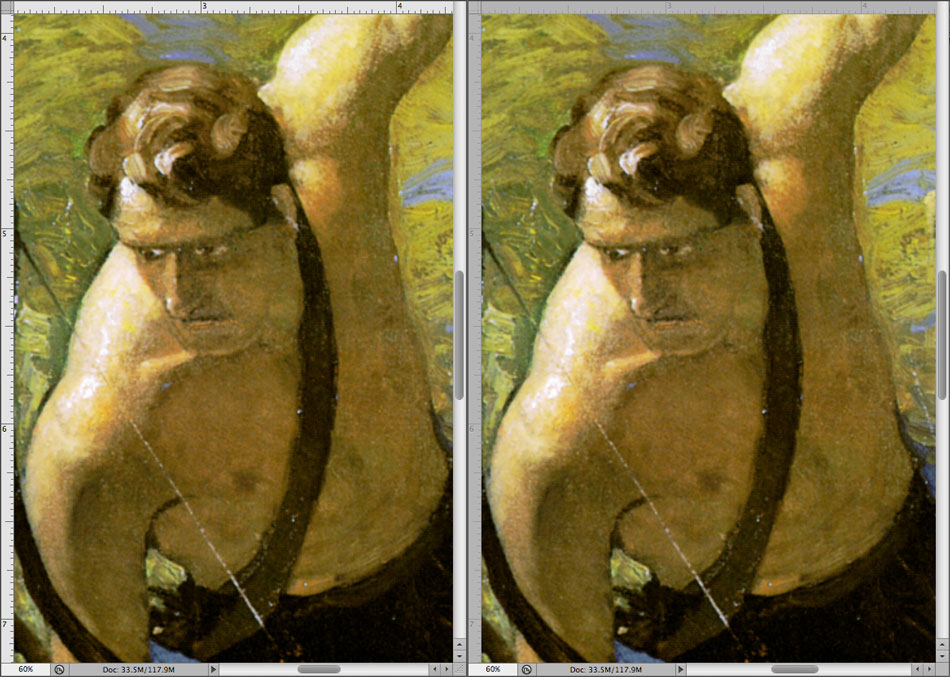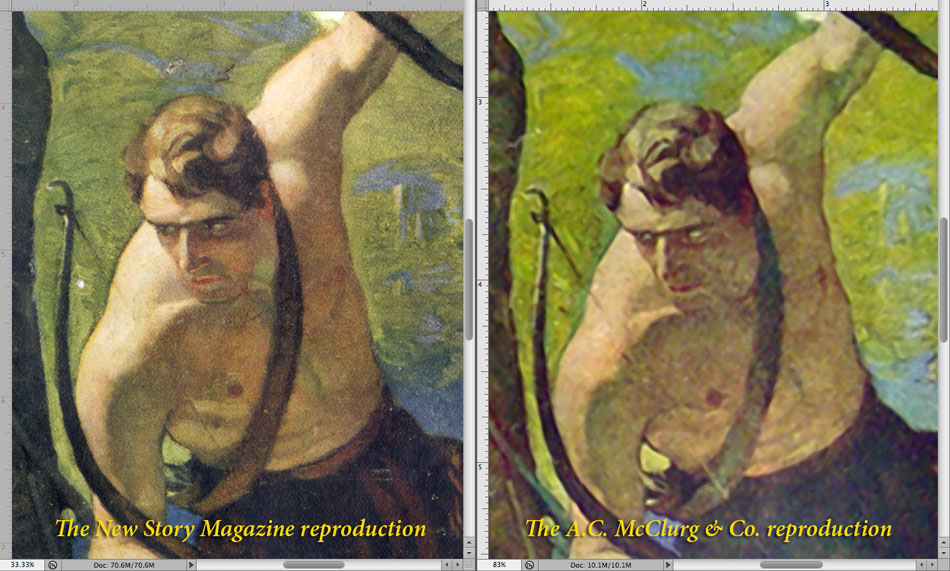THE WYETH / TARZAN REPORT — Part 4
©2014 Philip NormandConclusions: The Restoration of THE RETURN OF TARZAN Painting
THERE CAN BE LITTLE DOUBT that the painting Hulbert Burroughs purchased in 1965 from Graham Gallery is the original of the illustration used on the New Story Magazine cover in August of 1913, and on the dust-jacket for the first edition from A.C. McClurg & Co. in 1915, and all subsequent reprints. However, it is also clear that something happened to the painting between the time McClurg had it photographed for new plates and when it was photographed as a black-and-white cut for the American Heritage article in 1965.
The painting had apparently been in Street & Smith's inventory for decades. Had it been damaged and some well-meaning soul tried to fix it — much like, but not as horribly, as Cecilia Gimenez did for the Ecce Homo in the Santuario de Misericordia? (http://tinyurl.com/ct87yoo) This is the best, and most charitable, explanation possible. Any other cause would be sheer vandalism.
Though nothing had ever been mentioned about the discrepancies in the world of Burroughs fandom, that did not mean that they were altogether ignored. In 1997 Dark Horse Comics contracted with Thomas Yeates, currently the artist on the PRINCE VALIANT newpaper strip and a long-time ERB fan, to do an adaptation of THE RETURN OF TARZAN in three issues. On the back of the first issue was a reproduction of the Wyeth painting with a caption stating when and where it was used. Yeates, long bothered that anyone would think that the painting represented the master illustrator’s skills, had spoken to his editor for the adaptation, Peet Janes, about having the face from New Story superimposed over the face in the painting so that the comic would have a restored N.C. Wyeth on the cover. That didn't happen, but Janes apparently called Danton Burroughs, grandson of ERB, to ask him about the differences and Danton had no information to give him. Then he called Robert Barrett, noted ERB collector and scholar, to ask what he knew about why the painting looked the way it did. Barrett had nothing to tell him either. Finally, on the third issue of the comic's back cover, both of the Wyeth New Story covers for RETURN were printed with a note reading: “… Of particular interest are the perceived differences between the version of the painting at right [the New Story cover for August, 1913] and the version of the painting that appeared on the back cover of The Return of Tarzan #1 [the comic book]. Among the theories that account for the differences: A) Changes in the reproduction of Wyeth's painting between the magazine-cover use and the book-cover use, or B) Wyeth himself retouched the painting in between uses. If any fans have theories of their own, we'd love to hear them!”
This was the first public acknowledgement that there were notable differences between the painting and its reproductions. It is hoped that this report has put these two theories to rest. Theory A accounts for changes between photoengravers only, and theory B is unlikely given that 1) the painting was always in the offices of Street & Smith except when it was, possibly, sent to Chicago to be re-plated for the first book edition, and 2) the touchup work is completely inferior to anything that Wyeth would have done.
* * * * * * * * *
NOW THE QUESTIONS ARE: Can and should the painting be restored ? How would that be possible given that the two source reproductions show the face and figure with different details and brush passages ? Should anything be done to the painting without deeper investigation into its physical nature and state?
Edgar Rice Burroughs, Inc. as the owner of the piece is the only one who can answer these questions, but we can speculate on what course seems best.
FIRST, should the painting be restored? Yes, I believe it should be, given the conditions I will mention below. At this point the painting only represents N.C. Wyeth in the background and foreground foliage. The strokes there are consistent in all reproductions and have to be considered as the original work of the artist. The figure, however, is a mix, from forehead to thigh, of modifications according to what we see in the source reproductions, and it would be preferable to find out how much retouching has been done and to have that corrected in order to better represent Wyeth's work.
SECOND, is any such discovery of the unretouched painting even possible? Yes, absolutely. Modern art authentication techniques involve the use of x-ray, infrared and ultraviolet photography, and microspectrography. X-ray has been used for over 100 years in art authentication. It is amazing what can be revealed by looking below the surface of a painting. All of these techniques are used to examine a painting more closely than the human eye can see, discovering earlier sketches, underpainting and preliminary work on many paintings. By looking behind the retouching that has been done it will be possible to see the original details of the painting and make decisions as to the correct restoration. More information about these methods can be found on the internet at sites like this one: ArtExperts.com
THIRD, should the painting be retouched in an attempt to restore it without these authentication methods? No, I don't believe so. Without knowledge as to what lies behind the paint no decision can be considered accurate. I have made the argument that the painting does not resemble either of the reproductions, both made within 2 years of its first state. That being so, it is absolutely necessary to discover what Wyeth’s true strokes and details were, as much as is possible.
FINALLY, the question of value of a restored painting is always in the air. Will the painting lose value if it is determined that restoration has been done? There are many famous and near-famous paintings in museums at this moment which have been restored and retouched in order to bring them back to their original condition. Many museums maintain research and conservation departments. Both the J. Paul Getty Museum in Los Angeles and the Winterthur in Winterthur, Delaware, are respected institutions that have conservation as one of their primary activities. In fact, a call to the Brandywine River Museum of Art, where the N.C. Wyeth Catalogue Raisonné resides, pointed me to the Winterthur which the Brandywine uses for all their own conservation work. Conservation and restoration of artworks, when provided by an expert in the field, can only add value to a noted work.
If ERB, Inc. were to decide to pursue this restoration, a move both artistically and historically significant, they could do no better than to consult with the Brandywine Museum, perhaps their Research Center, and find out what the next best move would be. ERB, Inc. might begin by referring them to this art forensics report. Brandywine should certainly be interested in examining the painting, researching and authenticating its surface and details and advising how and who best might do the restoration. I'm sure they can suggest someone who knows N.C. Wyeth's techniques from that period and how he worked for the pulp magazines.
* * * * * * * * *
How might a re-painted RETURN OF TARZAN look? I am not an expert in Wyeth’s technique or style, but I have created the graphic below to show a possible re-creation of the face detail on the painting. On the left, as it might look based on the New Story reproduction, and on the right, as it might look based on the A.C. McClurg & Co. dust-jacket. Without a deep examination of the painting through such authentication methods as referred to above, no fully accurate restoration is possible. This is only my attempt at correction by looking at the signs as I see them. It is my hope that this report might encourage ERB, Inc. to seriously consider taking the steps needed to have the painting authenticated and restored by experts who understand and are capable of reviving the true style of N.C. Wyeth, thus bringing back a long-lost and misunderstood painting to its place of excellence in the catalogue of his work.
Roll your mouse over the image to see how painted restorations might look.

Below are the original reproductions for comparison.

* * * * * * * * *
My thanks to Thomas Yeates for spurring me on to create this report when he contacted me with his “Justice for N.C. Challenge” e-mail in March of 2014. The lack of good source copies of the original reproductions has kept this issue in the dark for almost 50 years. Perhaps only artists and those familiar with fine illustration have been able to see the problem as it is, but for those of us who can see it, let us hope that once the truth is out, something can be done to correct it.
—Phil Normand, Recoverings & Normand Design, October, 2014
Phil Normand has been a graphic designer in Denver, Colorado for over 45 years. Besides maintaining his design practice during that time, he taught at the former Rocky Mountain School of Art and Design, instructing in Production, Graphic Design, History of Graphic Design, and Typography. He was also Advertising Art Director at The Rocky Mountain News for seven years. Since 1999 one of his projects has been a complete reconstruction of the catalogue of first edition dust-jackets for the novels of Edgar Rice Burroughs using digital versions of the original metal type and upgrading the cover art using high-resolution photos of the original paintings when obtainable. He holds an exclusive licence to produce authorized reproductions of the dust-jackets made for the novels published by Burroughs’ own company from 1931 to 1948. Finished dust-jackets are available at Recoverings.com.